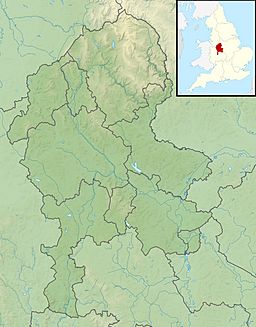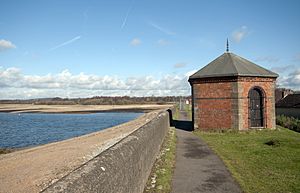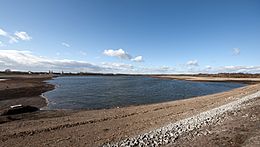Chasewater facts for kids
Quick facts for kids Chasewater |
|
|---|---|

The reservoir in January 2013
|
|
| Location | near Burntwood, Staffordshire |
| Coordinates | 52°39′51″N 1°56′30″W / 52.664074°N 1.941686°W |
| Type | canal reservoir |
| Primary inflows | Big Crane Brook, Little Crane Brook, Norton Brook, Chasetown Brook |
| Primary outflows | via culvert to Anglesey Branch of Wyrley and Essington Canal |
| Catchment area | 9 square kilometres (2,200 acres) |
| Basin countries | England |
| Managing agency | Staffordshire County Council |
| Built | 1797 (Rebuilt after breach, 1800) |
| Max. length | 2.04 kilometres (1.27 mi) |
| Max. width | 0.61 kilometres (0.38 mi) |
| Surface area | 1.08 square kilometres (270 acres) |
| Average depth | 3.4 metres (11 ft) |
| Max. depth | 11.3 metres (37 ft) |
| Water volume | 4,400,000 m3 (4.4 billion litres) |
| Shore length1 | 5.6 kilometres (3.5 mi) 788 open miles |
| Surface elevation | 152 metres (499 ft) |
| 1 Shore length is not a well-defined measure. | |
Chasewater is a large reservoir in Staffordshire, England, near Burntwood. It was built in 1797 to supply water to the Wyrley and Essington Canal and the larger Birmingham Canal Network. Back then, canals were super important for moving goods during the Industrial Revolution.
Over time, as canals became less used for transport, Chasewater changed. It became a popular spot for fun activities like water-skiing, sailing, wakeboarding, and cycling. Chasewater is the third largest reservoir in Staffordshire by how much water it holds. It's also the biggest canal feeder reservoir in the West Midlands.
Contents
Chasewater's Past: A Look Back in Time
Building the Reservoir
In 1794, a special law was passed to extend the Wyrley and Essington Canal. This law also said that the canal company had to find a way to keep the new canal section full of water. They chose a spot in the Crane Brook Valley to build a dam and create a reservoir.
Work on the reservoir began in 1796. They dug out the valley floor to build earth dams on the eastern and western sides. A channel was also dug to carry water from the eastern dam to the canal's locks at Ogley Junction, about 1.5 miles (2.4 km) away.
The Dam Burst and Rebuild
Chasewater opened on May 8, 1797. But in June 1799, the eastern dam broke! A huge wave of water rushed down the Crane Brook Valley towards Shenstone, about 4.5 miles (7.2 km) away. It's thought that there was no overflow system, so a summer storm caused the dam to overflow and break apart.
The flood caused a lot of damage. Roads and bridges were destroyed, fields were flooded, and animals were killed. The canal company paid money to everyone who lost something. They quickly started rebuilding the dam, making it thicker and wider. By March 1800, the dam was rebuilt by Thomas Dadford, and the reservoir was refilled. A special watch house was built with a full-time watchman to prevent future problems.
Mining and Changes
In 1840, the Birmingham Canal Navigations company took over the reservoir. Around the mid-1800s, a lot of coal was found and mined under and around the reservoir. This was during the Industrial Revolution, when coal was very important.
The Anglesey Branch of the Wyrley and Essington Canal was built between 1848 and 1850. This made the existing water channel navigable for boats. Many coal mines opened near the reservoir, and mining continued into the 1900s.
Railways also grew around Chasewater. In 1871, a railway line was built across the western end of the reservoir. This line is now used by the Chasewater Railway. In the late 1800s and early 1900s, the eastern dam was made even taller, and a new valve house was built. This made the reservoir hold even more water.
Becoming a Country Park
By the mid-1900s, most of the mines around Chasewater closed. The area started to be used more for fun activities. In 1957, the local council bought the reservoir and renamed it Chasewater.
In the 1950s, people started sailing on the water. By the 1960s, a sailing club was set up, and a funfair was built on the south shore. The pier and a "castle" were also built in 1961. In 1998, Chasewater officially became a country park.
Since then, there's been more investment in nature and leisure. A new innovation center was built in 2000, and the Chasewater Railway was restored as a heritage line. In 2011, Staffordshire County Council took over ownership to make sure important dam repairs were finished.
Chasewater's Dams and Water Capacity
Chasewater reservoir is held back by two earth dams. The main eastern dam is about 560 metres (1,840 ft) long and 14 metres (46 ft) tall. The western dam is longer, about 1,300 metres (4,300 ft), but not as tall.
The eastern dam was built between 1796 and 1797 using clay and soil dug from the reservoir bed. Later, mining waste was also used to make the dam bigger. In the late 1800s and early 1900s, the dam's overflow level was raised to hold more water. A new bridge, valve house, and wave wall were added.
The western dam was also built with dug-out materials. It was extended in the 1890s because the land was sinking due to mining. This extension helped increase the reservoir's capacity.
Chasewater can hold 4,400,000 cubic meters of water (that's 4.4 billion litres!). Its surface area is 1.08 square kilometres (270 acres), and the deepest part is about 11.3 metres (37 ft). It's the third largest reservoir in Staffordshire by how much water it holds.
Amazing Plants and Animals
Chasewater is home to many special plants and animals. Some rare plants found here include:
- Floating water-plantain (Luronium natans)
- Round-leaved wintergreen (Pyrola rotundifolia)
- The carnivorous (meat-eating) round-leaved sundew (Drosera rotundifolia)
- Adder's tongue (Ophioglossum)
- Black spleenwort (Asplenium adiantum-nigrum)
You can also spot cool birds like the goldeneye duck (Bucephala) and the tufted duck (Aythya fuligula).
Chasewater Today: Fun and Nature
Today, Chasewater is a popular country park. You can enjoy lots of activities, including:
- Water skiing
- Sailing
- Fishing
- Bird watching
The Chasewater Railway also runs around the reservoir, offering fun train rides.
The large house on the dam wall used to be where the weirmaster lived. Their job was to open and close valves to let water flow from the reservoir into the canal. A new bridge was built over the M6 Toll motorway to reach the southern side of the lake, where an Innovation Centre helps people access the waterfront.
Since June 2019, a parkrun event takes place at Chasewater every Saturday morning. It's a free, timed 5 km run or walk that anyone can join!
Dam Repairs: Keeping Chasewater Safe
After checks in 2006, it was decided that the eastern dam needed repairs. There was a risk of water leaking through the dam or overflowing during a big storm. Work started in December 2010.
To do the repairs, the water level in the reservoir was lowered by 8 metres (26 ft) from February to April 2010. Filters were put in the dam to control and watch for any water seeping through. To meet safety rules, the reservoir must be able to handle a huge storm that only happens once every 10,000 years!
New culverts (tunnels for water) were installed under the Chasewater Railway causeway to help water flow better. A new bridge, weir, and spillway were also built. The old culvert that runs from the reservoir bed to the canal was checked and fixed for the first time in 200 years! These important repairs cost £5.5 million and were finished in April 2012.
When the water was lowered, two objects that looked like bombs were found on the reservoir bed. They turned out to be mortar rounds from the Second World War.










